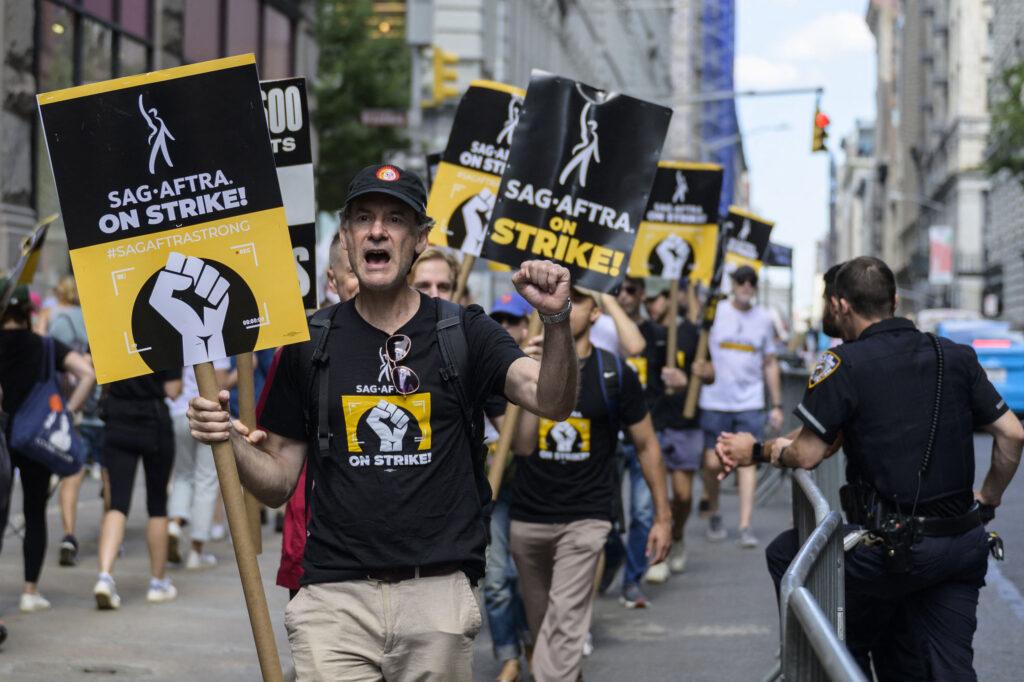A shocking scene occurred during the premiere of Christopher Nolan’s new film “Oppenheimer” at Le Grand Rex in Paris on July 11: The all-star cast, including Robert Downey Jr., Cillian Murphy and Florence Pugh, left immediately after walking the red carpet and did not stay to watch the movie.
Their absence was just one of many resistance efforts of the strike led by both the actors’ union, the Screen Actors Guild-American Federation of Television and Radio Artists (SAG-AFTRA), and the screenwriters’ union Writers Guild of America (WGA). Collectively, the two organizations — which consist of over 160,000 actors and 20,000 screenwriters in the U.S. — are responsible for protecting the creative and economic rights of their members.
The joint strike involving both SAG-AFTRA (from July 14 to Nov. 9) and WGA (from May 2 to Sept. 27) impacted the entertainment industry in many ways. Notably, it halted the production of numerous future productions and forced previously recalcitrant production studios to accede to demands for improved pay, working conditions and protections against new technologies.
The background and history of unions
The SAG-AFTRA strike caused an industry-wide shutdown and cancellation of films planned for the upcoming years. Sequels for popular series such as “Dune,” “The Lord of the Rings” and “Avatar” have been postponed as many as two years from their scheduled premiere dates.
A concurrent strike involving both SAG-AFTRA and WGA hasn’t occurred since the 1960s, which had the same cause as this year’s strike — demand for better compensation and conditions in the production process.
The ‘60s strike was successful in securing a larger portion of commercial sharings from the profit of the productions for actors and screenwriters. Within the technological context at the time — when actors’ and screenwriters’ jobs weren’t at risk due to advances in artificial intelligence (AI), like they are now — those new contracts and agreements made the entertainment industry more equitable and healthy.
The unique relationship between movie production studios and the two worker unions explains the origin behind both full-scale strikes. Most of the movie studios in the U.S. outsource their business coordination to the Alliance of Motion Picture and Television Producers (AMPTP), which acts like the union of filmmaking studios. Producers from the AMPTP meet triennially with SAG-AFTRA and WGA to negotiate actors’ and writers’ responsibilities and rights, including the minimum wage and maximum working hours.
The first cause: concern over artificial intelligence for writers
In recent years, these negotiations haven’t gone smoothly. With the AMPTP refusing to give up a large portion of streaming profits generated from online platforms to the workers, the unjust payment gap between the laborers and producers in the industry has been magnified.
To add fuel to the fire, the movie producers’ unregulated usage of AI further displeased both actors and writers. Due to recent major advancements in AI, computers can now produce a person’s voice, face or body and incorporate that into a film production. Because of this, SAG-AFTRA has particularly sought to protect their actors’ portrait rights in productions, the right to oppose the use of an actor’s image without their consent.
Though this technology has so far only been used to imitate and bring back a younger version of an actor — for example, a young Luke Skywalker appeared in the 2023 TV series “The Mandalorian” Season 2 — actors fear they will be replaced by AI-generated images of themselves that will be used in film productions without any compensation. More worrisome is that they could have virtually no control over a new technology that could eventually replace them.
In addition to the usage of AI-generated actor performances, many producers have also used AI for screenwriting, which had no regulation prior to the strike. Studios used AI tools to first write out a draft of the plot and then hired screenwriters to complete and revise the existing script. In this scenario, producers can justify paying the writers a lower wage because the writers are seemingly performing less original work, but in reality, it’s quite the opposite — screenwriters often have to contribute the same amount of effort into “revising” these creativity-lacking and incomplete AI-scripts as writing an original on their own. This abuse of AI incited concern from the WGA for their benefits and fair treatment in the future.
As a result, the WGA first stood up against the unregulated usage of AI in the industry in May. The union sought to advocate for the writers’ rights as laborers in an industry where public attention is focused mostly on actors, not the labor force behind productions.
The second cause: unbalanced gap in payment for actors
Most workers in the entertainment industry struggle to find their next job after a production is finished. Between productions, most actors and screenwriters face auditions and waiting time with unreliable sources of income. It is commonplace for a majority of non-celebrity actors — perhaps as much as 99.6% of the workforce — to miss a whole year’s salary from one production to the next. Even when they find a job, actors and screenwriters have to pay a considerable portion of their salary toward their agents’ commission fees, union dues and taxes. Actors, in particular, have further expenses such as paying public relations managers (PR) and styling costs out of their own pocket.
While the industry is driven by the mass number of laborers and actors, most of the profits from the productions end up in the pockets of skilled filmmakers, who are prioritized because their names carry more weight and generate more public attention.
One extreme example of screenwriters receiving disproportionate pay is Hwang Dong-hyuk, the creator of the record-breaking Netflix series “Squid Game,” whose series generated nearly $1 billion in profit for its streaming platform. Hwang, however, received “virtually nothing” out of the work’s success, as most of the profit went to Netflix and production studios.
In addition to screenwriters, actors are also commonly subjected to unjustifiably low compensation for the amount of effort and successful roles they’ve created. For example, Jonah Hill, who played Donnie Azoff in Martin Scorsese’s world-famous “The Wolf of Wall Street,” received a paltry payment of $60,000 while the movie’s budget was $100 million.
The deep-rooted issue facing both actors and screenwriters can be partly attributed to the nature of how the film industry functions. This system is perpetuated by film producers, who do not share a closely tied common interest with the worker unions. Such a cycle is what made the full-scale strike necessary for both unions.
A new era of the industry requires new solutions
Although the last strike in the ‘60s was a success, these agreements established over 60 years ago did not account for many of today’s rising technologies, including online streaming platforms.
Each time a new streaming platform was launched, SAG-AFTRA and WGA have had to negotiate profit sharing with AMPTP. Due to the latter’s uncompromising attitudes, a compromise standardizing the sharing of streaming revenue between actors, screenwriters and film producers was never established in the years leading up to the strike.
The failure of successful productions to balance and subsidize lesser known actors and screenwriters has reduced the profit deserved for the majority of small laborers in the industry.
The WGA ended its strike on Sept. 27 and SAG-AFTRA on Nov. 9, making the latter’s 118-day long strike the longest in Hollywood’s history. With both unions reaching a tentative agreement on a new 3-year contract with AMPTP addressing the core issue regarding streaming revenue and the use of AI, actors and screenwriters finally resumed their working.
In these newly constructed contracts with AMPTP, both unions have achieved what they’ve been seeking for: For screenwriters, studios can no longer deploy AI to create work and leave WGA members to add the finishing touches to the script; for actors, the minimum compensation has been increased by 11% and bonuses from streaming platform’s profit are made possible.
The SAG-AFTRA and WGA strikes this year plausibly mark the beginning of a healthier new era in the entertainment industry where both decades-old and newly rising issues have been properly addressed. Sixty years after the last full-scale joint strike, both worker unions succeed again in their mission to protect the members’ creative and economic rights.




























